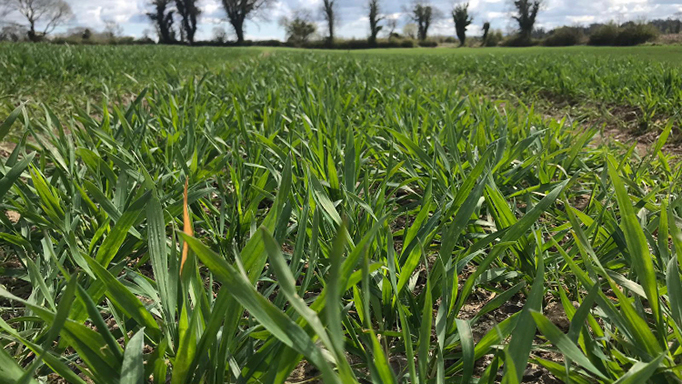April 2021 Crop Update

Ground conditions have dried up nicely allowing farmers an opportunity to complete fieldwork. Spring barley sowing is almost complete with crops being planted in the ground in good conditions.
Ground
Ground conditions have dried up nicely allowing farmers an opportunity to complete fieldwork. Spring barley sowing is almost complete with crops being planted in the ground in good conditions. A small acreage of spring wheat has also been planted along with spring oats.
Winter Wheat
Weed Control and Crop Nutrition
Many winter wheat crops have received their herbicides with limited amount of Autumn herbicide applications completed. Where Autumn applications where made, spring clean-up herbicides have been applied at this stage where required.
All crops of winter wheat have received their first split of nitrogen (40-50 units/acre) by this stage. Growers should have their main split of nitrogen applied by GS 31/32. Apply the balance of the crops nitrogen requirement by GS 37/39.
Forward winter wheat crops are beginning to reach growth stage 30 -31 and T0 sprays have been applied to some early crops while other crops will receive this T0 spray in the coming week as soon as weather conditions get milder. The recent unseasonable cold temperatures have delayed application of PGR’s to crops.
Where rust is an issue, particularly in the varieties Bennington and JB Diego this T0 application will consist of a strobilurium and or triazole mix. If mildew is active then a mildewicide will be required. Where T0 fungicides are required, this can be combined with the PGR. PGR options will be a CeCeCe and Moddus / Medax Max combination in order to minimize lodging at growth stage 30 - 31.
T1 fungicides will come later in the month and should be applied to the crop when the third last leaf has fully emerged and will be based on a Triazole + SDHI + Folpet mix. Products such as Elatus Era, Lentyma, Ascara Xpro, Elatus plus + Plexeo or Peacoq+Pontoon will be used. For mildew control add 0.3-0.5l/ha of Tern. It is important to alternate Triazoles throughout the spray programme.
Winter Barley
The early part of the month of April brought a unseasonable cold wheather but overall winter barley crops are looking promising. All winter barley crops should have received there final application of Nitrogen .
Winter barley crops have now received a T1 fungicide with crops at growth stages from GS25-31. The T1 on these varieties is very robust targeting Ryncho, Mildew and Net Blotch in particular. Programmes would have consisted of products such as Boogie, Decoy+ Comet, Elatus Era and Zephyr. T1 fungicides should can be combined with a PGR in the form of CeCeCe /Medax Max /Moddus (0.2 L/ha) or K2 at 1.0/Ha to minimize lodging at growth stage 30 - 31. This is of particular importance to hybrid varieties that are susceptible to lodging.
The T2 fungicide or “holding spray” mix will target Rynchosporium, Net Blotch and Mildew and will mainly include SDHI based products including Decoy+ Comet, Elatus Era or Zephyr. T2 on barley will be applied at GS 32-37 (second node-flag leaf emerging). For mildew control, add Tern at 0.3-.5L/ha. Folpet (Arizona/Mirror) should be included at T2 on all varieties to protect against the early onset of Ramularia. Flopet should be used in situations where the threat of Ramularia is high or where the crop has suffered from stress early on. A final PGR application based around Terpal should also be considered at this stage. It is important for growers to remember that only two applications of SDHI are permitted on crops of winter barley, as this will affect product choice at T3 if SDHI has been applied in the first two applications.
Winter Oats
The recent drop in air and soil temperatures have slowed down growth in oats across the country. Crop growth stages range from GS30-GS32. Plant stands ae generally very good and disease levels are low. There are a number of actions, which oats require over the next few weeks including finishing plant growth regulation and disease control. Protecting the emerging growth should be paramount and careful consideration of the plant protection products is required.
Products such as Boogie/ Decoy+Comet combined with Flexity or Talius should be used in the as mildew prevention is critical. Add Tern/Midas if mildew is already present in the crop.
Fertiliser
Nitrogen application should be completed on Oats at GS 32/33 and ensure adequate amounts of Potash is applied. Potash can be applied with final applications of nitrogen in products such as Masterboost. Certain fields will need trace elements corrected also. Check soil test reports for trace element deficiencies and apply a suitable formulation to supply early crop requirements.
For more information, please contact your local Glanbia Ireland Agronomist, branch or visit glanbiaconnect.com.
First Published: 13 April 2021
Tagged with: Tillage
